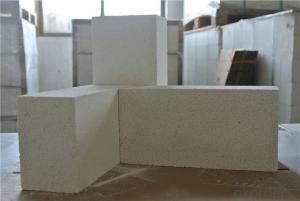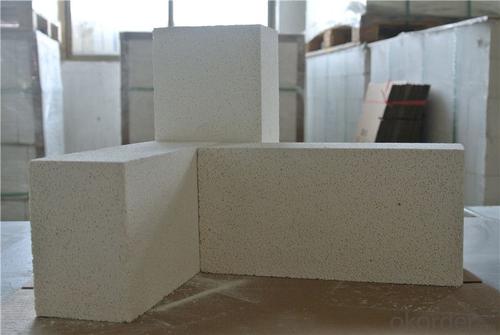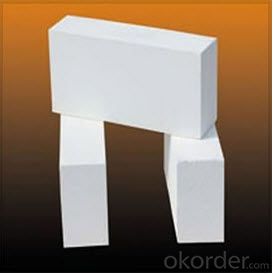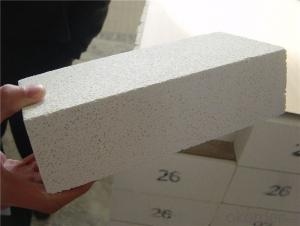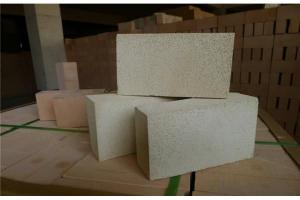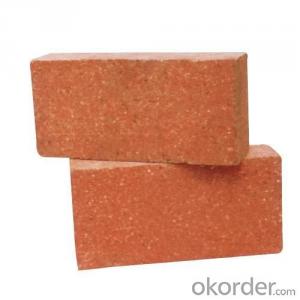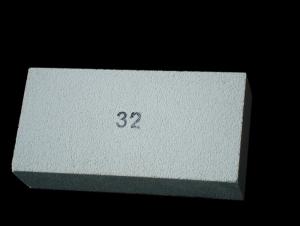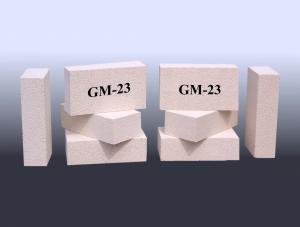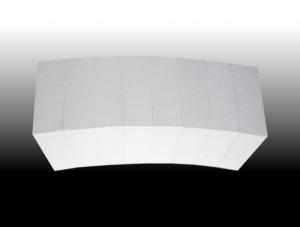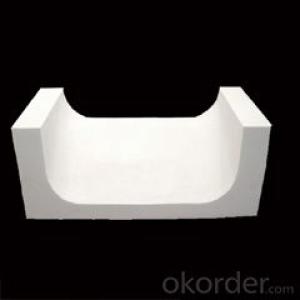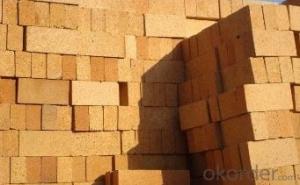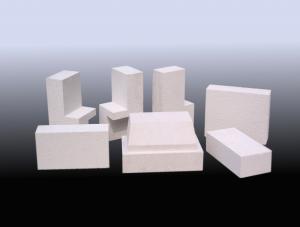Insulating Fire Brick - Lightweight Fire Clay
- Loading Port:
- Tianjin
- Payment Terms:
- TT OR LC
- Min Order Qty:
- 20 m.t.
- Supply Capability:
- 10000 m.t./month
OKorder Service Pledge
OKorder Financial Service
You Might Also Like
CNBM conforms strictly to the requirements of ISO 9000 quality control system during the production. MSDS is also available if you want. The thermal insulation fire clay brick meet with the requirements of ASTM & JIS standards. So pls stay cool with our quality.
Insulating Fire Brick Technical index
Product No. | IFB70 | IFB60 | IFB50 | IFB40 |
Al2O3 | 68%-72% | 58%-62% | 48%-52% | 38%-40% |
Refractoriness (°C ) | ≥1790 | ≥1790 | ≥1790 | ≥1790 |
Bulk density (g/cm3) | 2.50-2.60 | 2.35-2.45 | 2.20-2.30 | 2.10-2.20 |
Apparent porosity (%) | 22 | 19-22 | 17-20 | 17-20 |
Cold Crushing strength (kg) | 480-510 | 450-480 | 430-450 | 390-430 |
Application
Insulating Fire Brick are used for the lining of converter, alternating current arc furnace, direct Current arc furnace and the ladle slag line, etc.
Equipment
1 unit of Ceramic Abrasive (SG Abrasive) pilot production line
2 units of Compact grain Abrasive pilot production lines
1 unit of high-end coated abrasives (abrasive cloth) production line
2 units of Boron Carbide production lines
3 large flexible crushing and sieving lines for grit production lines
2 units of 2000KVA furnaces for Boron Carbide fusion
6 units of 5000KVA-10000KVA dumping type electric arc furnaces for Brown Fused Alumina fusion
Company Advantage
(1)Long Insulating Fire Brick manufacture history: 25 years manufacturer
(2)Advanced equipment
(3)Diversification of production standards: ISO ANSI FEPA JIS ASTM
(4)Flexible payment: T/T L/C D/P D/A
(5)Professional marketing team and after-sale service
(6)Free sample


- Q: Difference between inorganic insulation material and organic thermal insulation material
- 1, organic insulation material with light weight, good processability, high compactness, good insulation effect, but the disadvantage is: aging resistance, deformation coefficient, poor stability, poor security, easy combustion, ecological environmental protection is poor, difficult construction, construction cost is higher, and the limited resources. It is difficult to recycle.2, inorganic insulation materials with energy-saving, waste, heat insulation, fire protection, antifreeze, anti-aging and excellent performance, as well as low prices and other characteristics, can achieve A-level fire protection, has a wide range of market demand.
- Q: Can insulating fire bricks be used in the construction of fireplaces?
- Yes, insulating fire bricks can be used in the construction of fireplaces. These types of bricks are designed to withstand high temperatures and provide insulation, making them ideal for lining the interior of fireplaces. They help to retain heat, improve energy efficiency, and protect the surrounding materials from excessive heat.
- Q: Can insulating fire bricks be used in residential applications?
- Yes, insulating fire bricks can be used in residential applications. They are commonly used in residential fireplaces, wood-burning stoves, and pizza ovens to provide insulation and increase energy efficiency. Their high heat resistance and insulating properties make them suitable for these applications.
- Q: How do insulating fire bricks affect overall heating and cooling costs?
- Insulating fire bricks can have a significant impact on overall heating and cooling costs. These bricks are specifically designed to have low thermal conductivity, which means they are excellent at preventing heat transfer. By using insulating fire bricks in the construction of a building, the amount of heat loss during the colder months is greatly reduced. This results in less energy being needed to maintain a comfortable indoor temperature, leading to lower heating costs. Similarly, during the warmer months, insulating fire bricks help in keeping the heat out and maintaining a cooler indoor environment. This reduces the reliance on air conditioning systems, resulting in lower cooling costs. The high thermal resistance of these bricks helps to minimize heat gain from the external environment, thus providing a more energy-efficient solution. Furthermore, the use of insulating fire bricks can also contribute to the long-term durability and efficiency of heating and cooling systems. By reducing the workload on these systems, they can operate more efficiently, resulting in less wear and tear and potentially extending their lifespan. This can lead to additional cost savings by avoiding the need for frequent repairs or replacements. Overall, insulating fire bricks can provide substantial benefits in terms of reducing heating and cooling costs. By improving thermal insulation, they help to create a more energy-efficient building, which ultimately translates into lower utility bills and a smaller carbon footprint.
- Q: Is it possible to recycle broken insulating fire bricks?
- Yes, it is possible to recycle broken insulating fire bricks. Insulating fire bricks are commonly made from materials such as clay and alumina, which can be recycled. The broken bricks can be crushed into small particles or ground into a fine powder, and then mixed with other materials to create new bricks or other construction materials. Additionally, some recycling facilities may accept broken insulating fire bricks and process them for reuse in other industries. Recycling broken insulating fire bricks helps to reduce waste, conserve resources, and minimize the environmental impact associated with manufacturing new bricks from scratch.
- Q: Are insulating fire bricks resistant to moisture or water damage?
- Yes, insulating fire bricks are resistant to moisture or water damage. They are designed to withstand high temperatures and do not absorb water, making them a suitable choice for applications where moisture or water exposure is a concern.
- Q: Can insulating fire bricks be used in the construction of heat exchangers?
- Yes, insulating fire bricks can be used in the construction of heat exchangers. Insulating fire bricks are designed to have excellent thermal insulation properties, which makes them ideal for applications where high temperatures need to be maintained or controlled. Heat exchangers are devices that transfer heat between two or more fluids, and insulation is crucial to prevent heat loss or gain during the process. Using insulating fire bricks in the construction of heat exchangers helps to minimize heat transfer to the surrounding environment, resulting in improved energy efficiency and reduced operating costs. The bricks can withstand high temperatures, typically up to 3000°F (1650°C), making them suitable for various heat exchanger applications, including furnaces, boilers, and industrial processes. Additionally, insulating fire bricks are lightweight and have low thermal conductivity, which means they provide effective insulation while being less bulky and more cost-effective than traditional refractory bricks. This makes them easier to handle and install in heat exchanger systems. Overall, the use of insulating fire bricks in the construction of heat exchangers offers several advantages, including enhanced thermal insulation, improved energy efficiency, and reduced costs.
- Q: How do insulating fire bricks help reduce heat loss through convection?
- Insulating fire bricks help reduce heat loss through convection by trapping air within their porous structure. This trapped air acts as a barrier, preventing the transfer of heat through convection currents. The bricks' low thermal conductivity also minimizes the movement of heat, further reducing the loss through convection.
- Q: Can insulating fire bricks be used in heat exchangers?
- Insulating fire bricks are indeed applicable for heat exchangers. Their design aims to provide exceptional thermal insulation, making them perfect for high-temperature scenarios like heat exchangers. These bricks are crafted from lightweight substances and possess minimal thermal conductivity, enabling them to effectively minimize heat loss or gain within the heat exchanger. Furthermore, insulating fire bricks exhibit remarkable resistance to thermal shock and can endure extreme temperatures, solidifying their reliability for heat exchanger applications. Ultimately, incorporating insulating fire bricks in heat exchangers can enhance energy efficiency and overall performance.
- Q: What is the average density of insulating fire bricks?
- The average density of insulating fire bricks typically ranges from 0.6 to 1.2 grams per cubic centimeter.
Send your message to us
Insulating Fire Brick - Lightweight Fire Clay
- Loading Port:
- Tianjin
- Payment Terms:
- TT OR LC
- Min Order Qty:
- 20 m.t.
- Supply Capability:
- 10000 m.t./month
OKorder Service Pledge
OKorder Financial Service
Similar products
Hot products
Hot Searches
Related keywords
